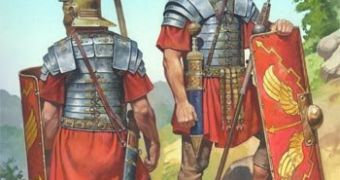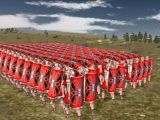Romans created and maintained the greatest ancient Empire for centuries, spreading their Greek-influenced culture. Their culture was the model for subsequent European cultures. About 40 % of the people in the European Union speak a language of Latin origin (French, Italian, Spanish, Portuguese, Romanian and others).
But the power of the Roman Empire relied on its army and, when the Roman army and its tactics failed, the Empire fell. Following the battle of Actium (31 BC), Octavian reorganized the Roman Army. The base of the army was made of 25 legions, cantoned at the borders of the empire. Emperor Trajan (98-117 AD) raised the number of legions to 30 and Septimius Severus (193-211 AD) to 33. Severus granted his soldiers the right to marry even while still in the army.
In ancient Rome, all the handy men (except for the poor ones) who were Roman citizens were enrolled in the army until they were 30 and were kept as reserves for another 14 years. Initially, the soldiers paid for their equipment, but after a while, they turned professional. In critical moments, mercenaries were employed.
The supreme chief of the army was the emperor; he decided careers, payments, gratifications and release from military service.
The pedites (infantry) were assigned in principes (first line soldiers), triarii (reserves) and hastati (spear throwers). There were also auxiliary troops, formed by allies or incorporated troops from the conquered territories. The Romans also had chivalry, made especially of patrician sons, and divided in decuriae (lines of ten); three decuriae formed a turma (squadron). Chivalry had little use in the Roman army and was more a means of ascension.
A normal infantry trooper wore a cassis (helmet) made of bronze or leather; a metal, leather or skin lorica (armor), a large and heavy scutum (shield), the glaucius (sword) which was short, double bladed and a pilum (lance), 1.8 m long. A centurion (commander of 100 troopers) wore a tuft on his helmet and also a vitis (vine branch), both pointing to his rank. The Roman standard wore the eagle (which was the symbol of a legion) and the letters SPQR (Senatus Populusque Romanum - The Roman Senate and People), its motto, as the symbol of the balance between democracy and people. The standard was carried by the aquilifer, the bravest soldier.
A legion had 4.200 and 6.000 infantry troops, divided in centurias (100 troopers), manipulos (two centurias) and cohorts (three centurias). Ten cohorts formed a legion. The cohorts were divided in centuriae, units made of 100 soldiers. Local cohorts and militias existed in the provinces, while in Italy and Rome just city guards and praetorian guards served.
Auxiliary troops made infantry or chivalry cohorts; they consisted of non-citizens from the provinces and barbarians and were associated to the legions for 25 years. The auxiliary service allowed the autochthonous people to receive the Roman citizenship at the end of the military service. They also received 12,000 sexterts (the currency in the Empire), a land plot, the right to marry and other advantages registered on a bronze plate called Military Diploma.
Veterans installed in the given land contributed to the romanization of the neighboring populations, as was the case of the encampment of Timgad, in Algeria. The presence of a military encampment attracted subsequently the installation of civilian population nearby, and settlements installed near Roman camps were, in many cases, at the origin of many modern cities (like Strasbourg in France, Mainz in Germany, Leon in Spain).
The Roman army was also very important in building roads, bridges and controlling mining, therefore being an essential element of the Roman administration.
To ensure exchanges between the parts of the empire and especially for facilitating the circulation of the troops and imperial messengers, the Romans built a network of strong rectilinear roads, edged by kilometric landmarks and inns. To the end of the 2nd century AD, 90,000 km (55,000 mi) of main roads served the great cities and military encampments.
The Roman attack consisted in infantry advancing until it was a few steps away from the enemy troops, which allowed them to throw the spears and proceed to side-to-side fight with the swords. The crucial element was to hold the line, which had not to be broken. The long shields were effective in close formation, but left the soldier vulnerable when isolated. Once the enemy troops moved back or gave up positions, the chivalry (some 300 riders for each legion) annihilated the defeated or made them prisoners. This worked in the case of the ancient static wars and sieges, but when the mobile riders coming from Asia, like the Huns, appeared, this tactic proved too slow.
Three Roman military tactics are famous.
One is the testudo (turtle) that received its fame due to the stories about Asterix and Oberlix. In it, the soldiers formed a compact rectangular mass protected by shields from flank, front, rear and above, against arrows and stones.
Triplex Acies was used by Julius Cesar. Soldiers were disposed in three lines: four cohorts in the first, three in the second and other three in the third.
Half moon formation was inspired by the Hannibal's troops and consisted in surrounding the enemy troops with the infantry, while the chivalry was staying on the rear guard.

 14 DAY TRIAL //
14 DAY TRIAL // 
